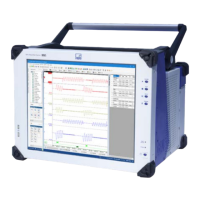GEN7iB
18
SAFETY MESSAGES
SAFETY MESSAGES
2
2.2 Grounding
The instrument must be used with a protective ground connection via the protective
ground conductor of the supply cable. The protective ground conductor is connected
to the instrument before the line and neutral connections are made when the supply
connectionismade.Ifthenalconnectiontothesupplyismadeelsewhere,ensure
that the ground connection is made before line and neutral connections are made.
Any interruption of the ground connection, inside or outside the instrument, is likely to make
the instrument dangerous. Intentional interruption is prohibited.
For protection against electric shock, all external circuits or equipment need a safe
insulation. Therefore, peripheral equipment must not be connected to the system with
a power supply without the SELV (Separated Extra Low Voltage) rating unless explicitly
mentioned.
Signal connections to the instrument should be connected after the ground connection
is made and disconnected before the ground connection is removed, i.e. the supply
lead must be connected whenever signal leads are connected.
For safety, it is essential that the protective ground connector of the instrument is used
whenever voltages greater than 33V RMS, 46.7V PEAK or 70V DC (IEC 61010-1:2010) are
connected. This is to prevent the instrument’s case becoming live in the event of a protec-
tive ground interruption, which could occur if the supply connector is accidentally discon-
nected from the instrument.
The primary purpose of protective grounding is to provide adequate protection against
electric shock that could cause death or injury to personnel while working on de-en-
ergized equipment. This is accomplished by grounding and bonding to limit the body
contact or exposure to voltages at the work-site to a safe value if the equipment were
to be accidentally energized from any source of hazardous energy. The greatest source
of hazardous energy in most cases is direct energizing of the equipment from a pow-
er-system or source.
If connection to a protective ground is not possible for any reason, then please refer to the
international safety standard EN 50191:2000

